


Framed or unframed, desk size to sofa size, printed by us in Arizona and Alabama since 2007. Explore now.
Shorpy is funded by you. Patreon contributors get an ad-free experience.
Learn more.

- Roll your own
- Rugged and real!
- A Charles Purcell - Mama Cass Connection
- Uncle SAAM
- Obfuscation
- One Chocolate Soldier rode away
- Victor Marquis de la Roche
- The Little House Across Way ...
- Vanderbilt Gates
- Vanderbilt Mansion
- You can still see that gate
- Withering heights for me
- So Jim,
- Top Heavy
- Re: Can't Place It.
- Bus ID
- Since you mention it
- The White Pages ?
- Moonlight Tower
- 1907?
- Fire(men) and Water
- Can't Place It
- Can anyone
- Wings
- Where's Claudette and Clark?
- Overbuilt Rolodex
- One song
- Give Me Wings Please!
- PRR
- Pinball Wizards
Printporium
Big Rigs: 1936

August 15, 1936. "Sterling trucks in San Francisco." With a chain drive that looks like something off a giant bicycle. 8x10 inch acetate negative. View full size.
Grandma's Truck
I remember my grandmother talking about driving a Sterling truck during the depression. She was able to get work one winter driving deliveries from a cheese factory in Beaver, Utah. She said the men were afraid to drive on the icy mountain roads, but she didn't know any better and was glad for the work.
After all these years, I remember the mention of Sterling trucks because I pictured them in my mind as gleaming silver, just like the silver in the display case we weren't allowed to touch.
Long lasting chains
Mack didn't drop chain drive entirely until circa 1950. Knuckey finally quit making trucks in the mid-1950s and Cook lasted into the mid-1960s. Kenworth offered chain drive models at least into the late-1950s and possibly a little longer. As others have noted, they had a number of advantages, especially for heavy loads on soft surfaces or other places where high clearance was needed. These drives were very tough, by the way. I don't remember ever hearing a story about a chain breaking, though it must have happened; the repair would have been relatively easy in any case.
Seals Stadium
As the proud owner of an Oakland Oaks replica warmup jacket, all I can say is "booooo" :-)
Seriously, it was a great rivalry, and the inspiration for some terrific cartoons by Lee Sussman in the Oakland Tribune. I loved them as a kid. They usually came in pairs on succeeding days, one setting up a confrontation before a game (usually against the Seals) and the next one after the game based on who one.
The Bay Area in the 1950s was the closest to paradise that I'll ever get.
Sterling RIP 2010
Sterling was arguably the oldest brand-name truck in North America, having been in production off and on since the early 1900s to 2010. Originally produced under the name Sternberg, it was changed to Sterling in 1916 due to anti-German sentiment prior to WW1. The final version was basically a Ford Class 8 (heavy truck) design built by Daimler in St. Thomas, Ontario.
I remember Sterling trucks in my childhood; we could always hear an approaching Sterling because that chain drive gave them a unique sound.
Seals Stadium
That building in the left background looked suspiciously familiar. Turns out it's the late, deeply missed, "Seals Stadium" at the corner of 16th and Bryant Streets in San Francisco. Now THAT was a ballpark!
Built in 1931, Seals Stadium was home to the minor league San Francisco Seals until 1958 when the major league Giants moved from New York to San Francisco. The Giants played at Seals Stadium for the first two years in the city before moving to (shudder) Candlestick Park.
The Seals Stadium site is now a shopping mall.
Chains and Boxes
Chain drive had an advantage over rough or muddy ground; there was no axle and differential to get snagged. Note the chain oiling device; I'd be interested to see what the manual had to say about that ("stomp on the chain oiler pedal every 50 miles").
The box probably held the battery. They were high maintenance and needed easy access. The hoses are actually electrical cables.
Chain Gang
The advantage to chain drive was that the gearing could be easily changed for different conditions. Hilly roads or heavy loads, just swap out the drive sprocket with a smaller one. Flat roads or light loads, go to a bigger one took no time at all.
The box
What function does the box do on the floorboard? It has two hoses from it going forward.
The Chains
I believe, allowed the differential to be mounted solidly to the frame, which avoided universal joints in the driveshaft. There were chains on both sides, with independent drive to each. This allowed the axle to move up and down with the springing, and without the weight of the differential.
Chain function
perhaps the chain drives an accessory, such as a refrigeration compressor?
[The chain drives the wheels. - Dave]
The chains they revere
Hot cha cha, more Sterlings. Love 'em. But who can explain why the chain drive? What advantage did it offer over a differential built into the rear axle? Doesn't seem any simpler to me, or more mechanically efficient, but then I am no engineer.
Tires or Tyres
Whatever, they haven't changed much.
























On Shorpy:
Today’s Top 5